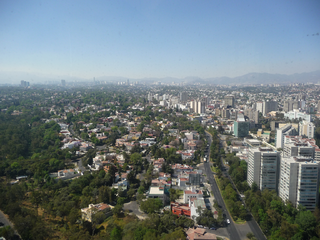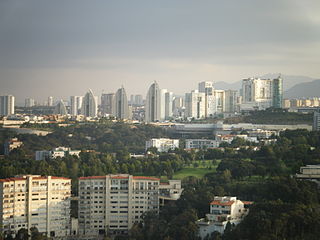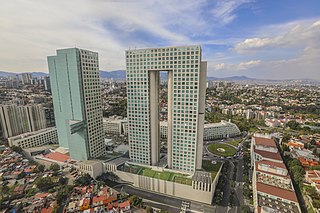Related Research Articles

Miguel Hidalgo is a borough in the Mexico City. It was created in 1970 when central Mexico City was divided into four boroughs. Miguel Hidalgo joined the historic areas of Tacuba, Chapultepec and Tacubaya along with a number of notable neighborhoods such as Polanco and Lomas de Chapultepec. With landmarks such as Chapultepec Park and the Museo Nacional de Antropología, it is the second most visited borough in Mexico City after Cuauhtémoc where the historic center of Mexico City is located. Tacubaya and Tacuba both have long histories as independent settlements and were designated as “Barrios Mágicos” by the city for tourism purposes.

Cuatro Caminos is a station of the Mexico City metro network. Colloquially known as "Metro Toreo", it is the current north terminus of Line 2. The adjacent Mexipuerto Cementos Fortaleza Cuatro Caminos mixed-use development opened in 2016 and houses, besides a shopping center, residential tower and sports facility, a bus terminal that is a hub for regional bus and minibus transport from and into the State of Mexico. In 2019, the station had an average ridership of 114,947 passengers per day, making it the third busiest station in the network.

Naucalpan, officially Naucalpan de Juárez, is one of 125 municipalities located just northwest of Mexico City in the adjoining State of Mexico. The municipal seat is the city of Naucalpan de Juárez, which extends into the neighboring municipality of Huixquilucan.

The Parque México, officially Parque San Martín, is a large urban park located in Colonia Hipódromo in the Condesa area of Mexico City. It is recognized by its Art Deco architecture and decor as well as being one of the larger green areas in the city. In 1927, when the surrounding neighborhood of Colonia Hipódromo was being built, the park was developed on the former site of the horse race track of the Jockey Club de México. Today, Parque México is not only the center of Colonia Hipódromo, it is also the cultural center of the entire La Condesa section of the city.

Colonia Roma, also called La Roma or simply, Roma, is a district located in the Cuauhtémoc borough of Mexico City just west of the city's historic center, and in fact is no longer a single colonia (neighbourhood) but now two officially defined ones, Roma Norte and Roma Sur, divided by Coahuila street.

Lomas de Chapultepec is a colonia, or officially recognized neighborhood, located in the Miguel Hidalgo borough of Mexico City. It dates back to the 1920s, when it was founded with the name Chapultepec Heights. Home to some of the biggest mansions in the city and many high-net-worth individuals, it has gained a reputation of exclusivity. Its main entrance is through Paseo de la Reforma.

Ciudad Satélite, commonly known as Satélite, is a Greater Mexico City upper middle class suburban area located in Naucalpan, State of Mexico. Officially, the name corresponds exclusively to the homonym neighborhood, Ciudad Satélite, founded circa 1957. With time, the area surrounding it, including upper-class neighborhoods like Lomas Verdes, Echegaray, Paseos del Bosque or Colonial Satélite, alongside adjacent municipalities Atizapán de Zaragoza and Tlalnepantla de Baz, have become collectively known as "Satélite", due to its prominence as both an economically and socially dynamic area.

Huixquilucan Municipality is one of the municipalities in State of Mexico, Mexico. It lies adjacent to the west side of the Federal District and is part of Greater Mexico City but independent of Mexico City itself. The name "Huixquilucan" comes from Nahuatl meaning, "place full of edible thistles".

Colegio Alemán Alexander von Humboldt, A. C. is a network of German-language primary and secondary schools based in Greater Mexico City.

Polanco is a neighborhood in the Miguel Hidalgo borough of Mexico City. Polanco is an upscale colonia, noted for its luxury shopping along Presidente Masaryk Avenue, the most expensive street in Mexico, as well as for the numerous prominent cultural institutions located within the neighborhood, such as the Museo Soumaya and the Colección Jumex. Polanco is often called the "Beverly Hills of Mexico", having one of the country's densest concentrations of luxury shopping, with the most upscale restaurants, high-net-worth individuals, upscale hotels, and diplomatic missions and embassies. It is one of the most expensive real estate markets in Latin America.

Condesa or La Condesa is an area in the Cuauhtémoc Borough of Mexico City, south of Zona Rosa and 4 to 5 km west of the Zócalo, the city's main square. It is immediately west of Colonia Roma, together with which it is designated as a "Barrio Mágico Turístico". Together they are often referred to as Condesa–Roma, one of the most architecturally significant and bastion of the creative communities of the city.

The Michoacán Market is a “mercado público" or traditional retail food market located in Condesa, one of the more prestigious districts of Mexico City. It is located between Avenida Michoacán, Avenida Vicente Suárez, and Avenida Tamaulipas streets, where three intersect.

Interlomas is an exclusive residential and commercial area in State of Mexico, Mexico, located 18 kilometres (11 mi) west of Mexico City's historic center and about 4.5 kilometres (2.8 mi) north of the Santa Fe edge city. Interlomas is a high class zone, compound by various colonies (neighborhoods) with really high incomes, it belongs to the municipality of Huixquilucan in the State of Mexico. As of 2011, it has a population of approximately 170,000.

Bosques de las Lomas is a colonia, or officially recognised neighbourhood, located in western Mexico City. It falls partly in Cuajimalpa borough and partly in Miguel Hidalgo borough. It was the masterpiece of Carleton F. Boyle, who previously was the CEO of Lock Joint Company. His good friend Don Carlos Trouyet owned the land & C.F. Boyle created the development which was the first borough in Latin America to have all the telephone & electrical lines run underground. The bridge in Bosques de las Lomas was the first of its kind in Latin America when C.F. Boyle hired French engineers to create it, and to this day Mexican Military Units use it for training exercises. The church design was chosen in a contest by C.F. Boyle by the architect Juan Cortina Del Valle, which has a vanguard design of a pyramid with a prominent stained glass window by the Hungarian-French artist Victor Vasarely.

José Luis Cuevas Pietrasanta (1881–1952) was a Mexican architect who planned the Mexico City subdivisions:

The Irish Institute is a catholic private school in Greater Mexico City. Operated by the Legionaries of Christ, the grounds, located in Naucalpan, State of Mexico, have separate areas for boys and girls, plus a third one for the coed preschool. The school levels in total range from preschool to bachillerato, equivalent to the American K-12.
British American School, S.C. is a private international school in Naucalpan, State of Mexico in Greater Mexico City. It serves levels kindergarten (Kinder) through high school (bachillerato). It was previously in Tlalpan, Mexico City.
Escuela Sierra Nevada is a private school in the Mexico City metropolitan area. It was established in 1950 and serves preschool through high school.
Grupo Educaativo. is an organization that operates private schools in the Mexico City metropolitan area. The schools are:
Colonia Ampliación Daniel Garza is a colonia in Delegación Miguel Hidalgo of Mexico City, part of that in its time was the old Villa de Tacubaya.
References
- ↑ Ciudad de México, 2014 Gran Formato. Guía Roji. 2014.
- ↑ "En Tecamachalco siguen violaciones al uso del suelo" [In Tecamachalco, zoning violations continue], El Universal (in Spanish), 2008-02-27, retrieved 2013-10-15
- ↑ Vivienne Stanton (September 13, 2010), The many faces of Jewish Mexico